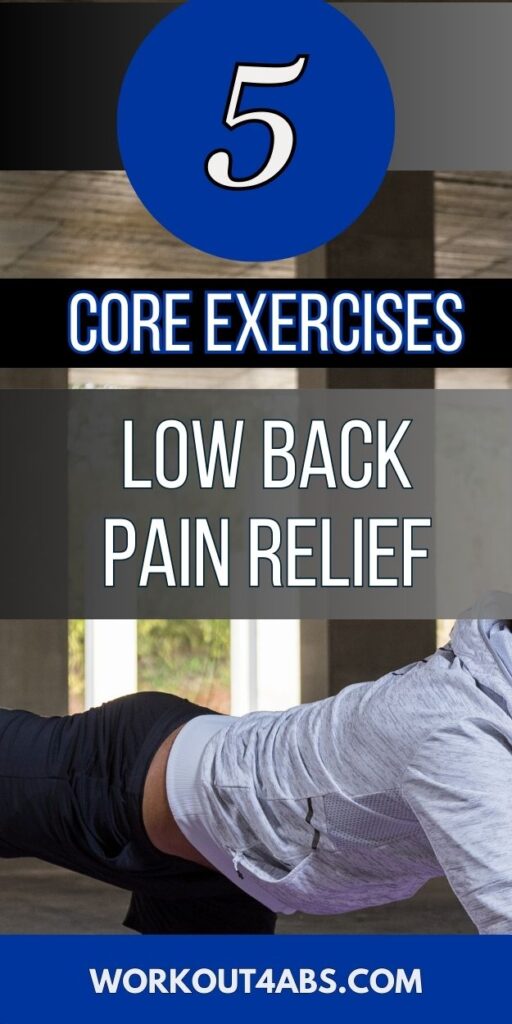If you’re looking for core exercises for low back pain relief, here is a safe and effective solution. The following are core exercises that require no equipment and can be done in the comfort of your home. In this article, we’ll explore these accessible techniques to help alleviate discomfort and build a strong, resilient core.
SAFE Core Exercises for Lower Back Pain Relief
If you enjoyed these tips, please save this pin to your Pinterest Board.

Bird Dog Core Exercise
The bird dog is a core-strengthening exercise that also improves balance and stability. It’s performed on your hands and knees and involves extending one arm and the opposite leg while keeping your back straight. Here’s a step-by-step guide on how to do the bird dog exercise:
Starting Position:
- Begin on all fours (quadruped position) on a comfortable exercise mat or the floor. Your hands should be under your shoulders, and your knees should be under your hips.
- Maintain a neutral spine by keeping your back flat and your head aligned with your spine.
- Engage your core muscles to provide stability throughout the exercise.
Execution:
- Lift your right arm off the floor and extend it straight in front of you. Your arm should be parallel to the floor, and your thumb should be pointing up.
- At the same time, extend your left leg straight back behind you. Your leg should also be parallel to the floor.
- Keep your hips and shoulders square to the ground, avoiding any twisting or tilting.
- Focus on maintaining a straight line from your fingertips to your toes.
- Hold this extended position for a moment, engaging your core muscles for stability and balance.
- Slowly return your right arm and left leg to the starting position, bringing your knee and elbow back to the ground.
- Repeat the movement on the opposite side by extending your left arm and right leg.
Tips:
- Keep your gaze down at the floor to maintain a neutral neck position.
- Breathe steadily throughout the exercise, inhaling as you extend your arm and leg and exhaling as you return to the starting position.
- Avoid arching your lower back or rounding your spine during the movement.
- Engage your core muscles to help stabilize your body and prevent excessive sway or movement.
- Perform 8-12 repetitions on each side for a complete set.
- Aim for 2-3 sets of the bird dog exercise in your core workout routine.
The bird dog is an effective exercise for strengthening the muscles of the core, including the rectus abdominis, transverse abdominis, and erector spinae. It’s particularly useful for improving core stability and balance, which can benefit overall posture and reduce the risk of back pain. Incorporate it into your regular core workout routine for a stronger, more stable core.
If you enjoyed these tips, please save this pin to your Pinterest Board.

Dead Bug Core Exercise
The dead bug is an effective core exercise that targets the abdominal muscles while also improving stability in the lower back. Here’s a step-by-step guide on how to perform the dead bug exercise:
Starting Position:
- Lie on your back on a comfortable exercise mat or the floor. Extend your legs fully and keep them together.
- Bend your knees at a 90-degree angle, so your shins are parallel to the floor. Your thighs should be perpendicular to the floor.
- Extend your arms straight up toward the ceiling, with your wrists over your shoulders. Keep your arms perpendicular to the floor.
Execution:
- Begin the movement by simultaneously lowering your right arm and your left leg toward the floor. Lower them slowly and under control.
- Keep your lower back in contact with the floor throughout the movement to engage your core muscles.
- As you lower your arm and leg, exhale and engage your abdominal muscles to prevent your lower back from arching off the floor.
- Lower your arm and leg until they are hovering just above the floor or lightly touch the floor without resting.
- Hold this position for a moment, feeling the tension in your core.
- Inhale as you return your right arm and left leg to the starting position.
- Repeat the movement on the opposite side by lowering your left arm and right leg while keeping your core engaged.
Tips:
- Maintain a controlled tempo throughout the exercise; do not rush.
- Keep your head and neck relaxed on the floor to avoid straining your neck.
- Focus on the mind-muscle connection and engage your core muscles throughout the entire movement.
- Keep your lower back pressed into the floor to prevent arching.
- Perform 8-12 repetitions on each side for a complete set.
- Aim for 2-3 sets of the dead bug exercise in your core workout routine.
The dead bug is an excellent exercise for building core strength, stability, and coordination. It also helps promote lower back health by strengthening the muscles that support the lumbar region. Incorporate it into your regular core workout routine for improved core function and a reduced risk of lower back pain.
Elevated Feet Glute Bridge Exercise
The glute bridge exercise with feet resting on a chair (elevated glute bridge) is a variation of the standard glute bridge that adds intensity by increasing the range of motion and engaging the glutes and hamstrings more effectively. Here’s a step-by-step guide on how to perform the elevated glute bridge:
Equipment Needed:
- A sturdy chair or bench
Execution:
- Setup: a. Place the chair or bench on the floor, near your exercise mat or workout area. b. Sit on the floor with your knees bent and your feet flat on the ground. c. Position the chair so that when you lie down on your back, your feet can comfortably rest on it. Your heels should be on the chair, and your knees should be bent at a 90-degree angle. d. Lie down on your back, keeping your arms by your sides with your palms facing down.
- Bridge Position: a. Press your heels into the chair, engaging your glutes and hamstrings. b. Inhale deeply, and as you exhale, lift your hips off the ground by pushing through your heels and squeezing your glutes. Your body should form a straight line from your shoulders to your knees. c. Make sure to keep your feet on the chair and your knees in line with your hips. d. At the top of the movement, your shoulders, hips, and knees should be in alignment.
- Hold and Squeeze: a. Hold the bridge position for a moment, focusing on squeezing your glutes at the top to maximize muscle engagement. b. Keep your core engaged and maintain a neutral spine throughout the exercise.
- Lowering Phase: a. Inhale and slowly lower your hips back down to the ground, returning to the starting position.
- Repetitions: a. Perform 10-15 repetitions of the elevated glute bridge, focusing on controlled movements and proper form.
Tips:
- Keep your weight evenly distributed between your feet on the chair and your upper back on the ground.
- Avoid pushing through your toes or the balls of your feet; instead, press through your heels.
- Maintain a steady breathing pattern, exhaling as you lift your hips and inhaling as you lower them.
- Keep your neck relaxed and your head on the ground during the exercise.
- To make the exercise more challenging, you can place a weight or resistance band across your hips or increase the duration of the hold at the top of the bridge.
The elevated glute bridge is an effective lower body exercise that targets the glutes, hamstrings, and lower back muscles. It can help improve hip stability, strengthen the posterior chain, and enhance overall lower body strength.
If you enjoyed these tips, please save this pin to your Pinterest Board.
